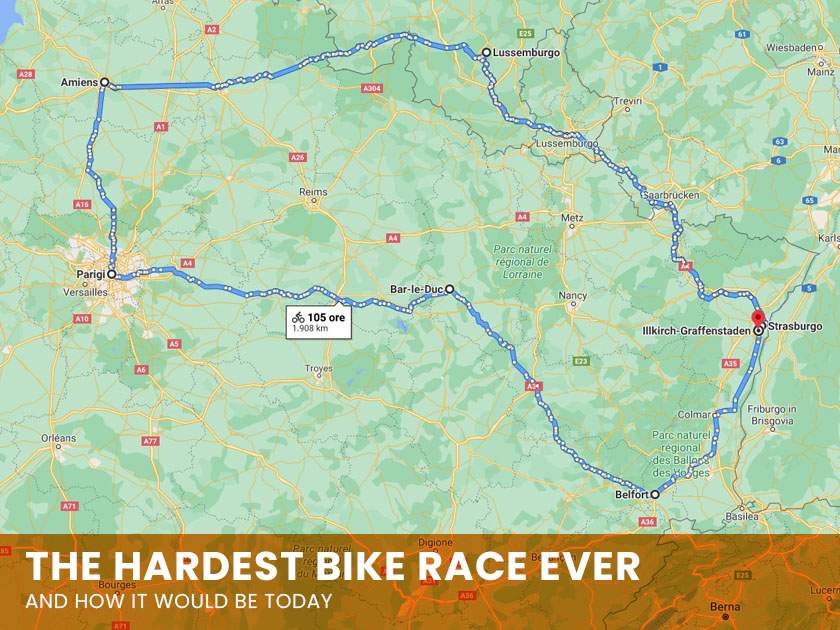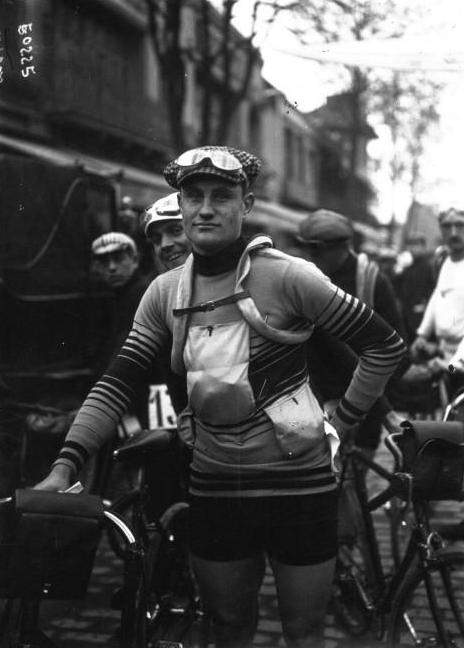FREE SHIPPING STARTING FROM 89€
Fast delivery with express courier
30 DAYS MONEY BACK GUARANTEE
The hardest bike race ever

Nowadays, we are familiar with high-performance bikes, technology and comfortable tracks designed for the enjoyment of cyclists. All these comforts once did not exist and some historical periods have been very difficult for bike lovers.
The record is undoubtedly due to the toughest bike race ever, disputed in the first post-war period in those territories that were just a battlefield a short time before.
So let's go back in time and try to recreate the same emotions (and difficulties) of the brave cyclists who ventured into this epic challenge. If the Paris Brest randonnée seems challenging to you, look at what the participants of the Battlefields Circuit have had to face...
The Battlefields Circuit
The idea of organizing a bike race on the former battlefields was put forward by the French newspaper Le Petit Journal, which had already conceived the Paris Brest Paris and now wanted to set up a race that would surpass by reputation the Tour de France. The jackpot for the winners of each of the 7 stages was very generous and the winner of the race would take home the equivalent of about 4 years' salary of a worker.
There were 140 entrants, but only 87 brave men showed up in Strasbourg for the start. Many cyclists were still involved with French troops, others had fought on the front and were not in the conditions to participate.
The rules were very clear: no bike exchanges between partners and every cyclist had to repair his bike alone and without help. The conditions of the circuit were extreme, with icy roads, cold winds and ground made impractical by the battles of a few months before.
On April 28, 1919, the riders left from Strasbourg and a 1,200-kilometre route awaited them that would take them to Luxembourg, Brussels, Amiens, Paris, Bar-le-Duc, Belfort and then back to Strasbourg.
Everything happened during the race, including irregularities, withdrawals and bike breakages. Let's go over this exciting adventure together!
The stages of the toughest bike race ever
Strasbourg-Luxembourg: the first stage
The first stage from Strasbourg-Luxembourg involved cyclists for 275 kilometers on roads crossed almost exclusively by military means. The terrain was in pretty good condition and the stage was won by Egg, of Switzerland, who had not fought in the war and could count on better conditions than his competitors.
This victory was probably helped by the bad organization of the race, which made the quartet that was in front of Egg go in the wrong direction. Some riders arrived just 10 minutes after the first one, while others were 8 hours late and there were also those who exceeded the maximum time, arriving at the finish line only the next morning.
Luxembourg-Brussels: second stage
After a day off, the second stage, Luxembourg-Brussels, started, 301 kilometers covered to the end by only 57 cyclists. All the others came out of time or retired, as happened to Egg, who broke his bike after a few kilometers.
The stage was won by Dejonghe, from Belgium, when the temperature was just above zero and many riders began to show the first signs of difficulty. It is said that the ninth arrived, a certain Deruyter, crossed the finish line with a woman's coat, taken who knows where to shelter from the cold.
Brussels-Amiens: third stage
The third stage Brussels-Amiens was the hardest: 323 kilometers of dirt roads where until recently the armies had fought. During the race there was also a snowfall and no one was able to get there in time. Some crossed forbidden passages and still others tried to corrupt the judges to change the arrival times.
The first to arrive was the rider with the coat, Deruyter, who took 19 hours, but there were also those who arrived the afternoon of the day after the start. Criticism rained down from all over the world for the bad organization and the extreme conditions imposed on the riders.
Amiens-Paris: fourth stage
Only 27 riders took part in the fourth stage of Amiens-Paris and the winner was Deruyter once again. In the first stage of the race the participants were still racing in the red zone, while the second part of the track was in better condition and a group of six riders started in a breakaway. He was awaited by 20,000 spectators at the Paris velodrome.

Charles Deruyter
Paris-Bar-le-Duc: fifth stage
The fifth stage Paris-Bar-le-Duc, with its 333 kilometers, was the longest and crossed the battlefields. Verdun, in particular, had been the scene of a long battle and some runners had fought there shortly before. Alavoine won, but Deruyter came second and was still firmly at the top of the general classification.
This stage was also studded with all sorts of improprieties, such as Duboc's, who changed bikes with a square mate and was disqualified. Only 21 riders remained in the race and the organization was forced to turn a blind eye to many other violations of the rules.
Bar-le-Duc-Belfort: sixth stage
The red zone was far away, but in the sixth stage Bar-le-Duc-Belfort there were also many difficulties. The Vosges mountain range and the 7% average gradient of the climbs put a strain on the riders and it is likely that many of them walked the more difficult sections. The winner was Heusghem, from Belgium, but Deruyter was still first in the standings.
Belfort-Strasbourg: seventh and final stage
The seventh and final stage, Belfort-Strasbourg, involved the riders for only 163 kilometers and was undoubtedly the easiest. Once again Deruyter came first and won the thousands of francs offered by the Petit Journal. The winner was about thirty years old and took part in other bike races without great success.
The hardest bike race ever... a century later
It's been 100 years since this epic race was done and I can't help but imagine what the race would be like today. Technological innovations have now become part of the everyday life of every cyclist and today, thanks to GPS, no runner would get lost, for example.
Due to the bad road conditions, many retreats were linked to broken bikes and some cyclists could not continue the race because they did not have the tools to repair it. Today such a situation is unthinkable, because the tool kits are small, light and can now be found in every cyclist's bike bags.
Hub dynamo that power the lights and recharges the batteries of mobile phones, thermal meshes that help to deal with the most extreme weather conditions and the same features of the frames, robust and lightweight, a century ago did not exist. This makes me think that today running on the circuit of battlefields would be very different and much more fun. Who knows if we can arrange a remake of this epic race!